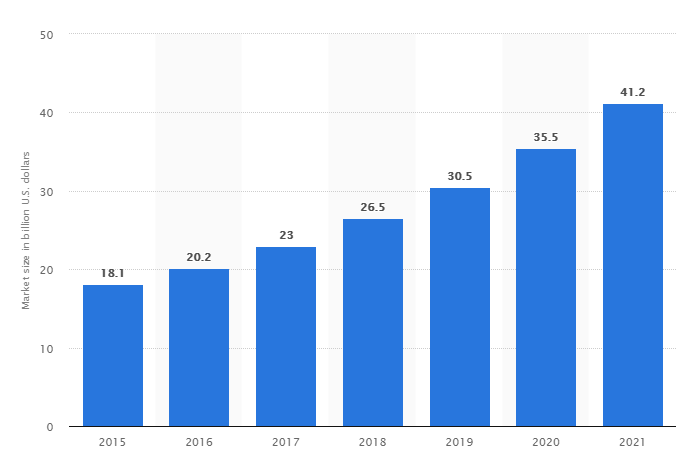A lot of myths and prejudice surrounds the concept of telemedicine. People refer to it as the dehumanization of care, “uberization” of health or simply discounted consultation in front of a display of a computer. In fact, telemedicine is a new way of bringing patients and caregivers together in a highly-organized network with good traceability.
According to Statista, the market for telemedicine is expected to grow to over 40 billion dollars until 2021.

The reason is simple: it is very convenient, the same as “brick-and-mortar” medicine, with the same opinions and follow-ups but not tied to any place in the world, so that you can get help wherever you are.
What is more, with telemedicine, patients have become active participants of their care: the process is more transparent, people understand what they want and choose the doctor that better matches with their needs and their personality.
In our new article, we’ll get to the bottom of the very notion of telemedicine, review the trends on the market and see the cases when it doesn’t fit.
What is telemedicine?
Telemedicine is a union of technology with health to provide remote care for patients. The primary cases of its usage were emergency situation and inaccessibility to healthcare institutions. For example, when an emergency doctors need advice from a remote neurologist or another narrowly focused specialist, they can organize tele-assistance with the help of video streaming, connected devices, or even VR.
However, with the growing global standard of health and the development of telemedicine technology, people strive for continuous, real-time care on demand, so telemedicine application goes beyond the urgent cases and extends over daily consulting and after-visit follow-ups.
Tele-consulting is the most common case for telemedicine. Normally, the technical solution includes the web or mobile app for remote consulting with the messaging system and video streaming or CTI integration, ability to exchange files and synchronize information with measurements from wearables and IoT devices. A patient can connect to their personal doctor, or find one using the matching algorithm, that pairs them with the required specialist. After that, they can schedule virtual visits or write whenever they need, in an emergency situation as well as in regular cases when they need to ask.
Nevertheless, the technology is not limited to counseling, it spreads over the number of medical practices, such as teleradiology, teleneurology, teleophthalmology, and many more. The most of them rely on the cloud-based workflow powered by data from connected health devices with the ability of real-time interaction with a client or online networking with another specialist. By the way, telenetworking is another powerful means to ensure the right remote treatment for a patient, as it allows doctors to transmit materials over a distance so that the right specialist reads the right study, measurement or picture to interpret them for diagnostic or treatment purposes.
As you can see, the general concept of telehealth includes every remote health activity backed by technology solutions, with the most of them serving for multiple purposes from video consulting to self-control functions, like telerehabilitation platform VeraHome which combines at-home and onsite physical therapy and virtual visits.
What are the trends disrupting telemedicine?
Here’s where we ask ourselves: what is the current state of telemedicine and where is it going?
Medical Tourism:
Ever more people travel abroad to get medical services, because of higher healthcare standards or lack of trust to local diagnosis. By 2025, the medical travel market could make over USD 3 trillion. As long as medical tourism is remote medicine by itself, it may benefit from telemedicine on several considerations:
- Before going abroad, patients often fail to do all the necessary tests beforehand or forget to bring existing results to a foreign doctor.
- At home, it’s easier for local doctors to pick up treatment, while they can track all care and procedures that were done abroad.
- Sometimes prescriptions from abroad are not locally supported; with telemedicine, home-based specialists can transmit them to local formulars or local devices.
- Prescriptions from abroad are not supported at home or are not compatible with local devices.
- After patients return home, they can receive a proper follow-up from a doctor.
EMR/EHR Integration:
Until recently, electronic medical records integration has been a challenge in telemedicine software. Now everything is changing; doctors can pull up patient information from EMR via PC or mobile device before a remote visit.
Typically, patients don’t see a difference after their telemedicine appointment until they can access visit summary within integrated patient portal. EMR/EHR intgeration allows the patient to view the telemedicine visit summary not separately but within the rest of the medical history.
Enhanced data security with blockchain:
With the increase of cyberattacks in recent years, patient data security remains the top concern for healthcare software providers.
One of the solutions for improved data protection is blockchain which stores electronic health records and data from connected health devices and enables better data access, reduces time delays and secures overall data sharing flow.
Gamification:
The other trend is implementing game tech into telemedicine. Many telemedicine companies are still reluctant to adopt the trend, as it may convey the wrong message to patients and make them treat their health not serious enough. However, those who have brought “games for health” into their telemedicine solutions has already attracted new-generation customers. The most popular of them is motion and nutrition tracking solutions for telefitness or telerehabilitation.
Virtual reality disruption:
VR is continuously changing the face of healthcare, and telemedicine is no exception. The technology is used mostly in telesurgery and augmented surgery allowing to perform an operation with a patient in a different location via the advanced communication interface. Now, researchers try to implement virtual environments in telerehabilitation and neural psychology for medical visualization.
Final takeaway
The success of telemedicine depends on two factors: that quality of care is not diminished for convenience and that there is a profitable reimbursement policy.
Soon, more brick-and-mortar health organizations will adopt the trend and overcome the fear to replace personal interaction. A common misconception is that telemedicine will lower the level of care. In fact, it’s not a replacement for traditional medicine, just an effective way of follow-ups, monitoring, and teamworking. Healthcare organizations, in their turn, may benefit from fewer losses caused by no-shows. This means they can increase their revenue and spread the reach of their care.
Have you thought about implementing telemedicine solutions into your care pipeline? What else do you want to know about telemedicine software? Leave your questions in our live chat!









